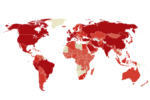
Key Points:
- Trump plans to increase tariffs on Canadian softwood lumber to 27% starting April 2
- Tariffs could eventually reach 50%, threatening critical toilet paper raw materials
- Northern Bleached Softwood Kraft Pulp (NBSK) from Canada is essential for US toilet paper production
- Industry experts warn of potential shortages reminiscent of 2020 pandemic panic buying
- US imported 2 million tons of Canadian NBSK last year with no viable domestic alternative
New Delhi: Americans may soon face another toilet paper crisis reminiscent of the early pandemic shortages, but this time the cause won’t be panic buying, it will be trade policy. President Donald Trump’s administration has announced plans to dramatically increase tariffs on Canadian softwood lumber, with potentially severe consequences for bathroom tissue supplies across the United States.
Understanding the Tariff Increase
According to multiple reports, the Trump administration intends to raise duties on Canadian softwood lumber to 27% beginning April 2, 2025, with the possibility of pushing rates to more than 50% through additional tariffs in the future. This dramatic increase would build upon existing duties that currently stand at approximately 14.5%.
The White House has framed these tariffs as necessary to protect American manufacturing and reduce dependence on foreign imports. Trump has repeatedly claimed that the United States doesn’t need Canadian lumber and that tariffs will encourage domestic production. This approach aligns with his broader “America First” trade strategy that characterized his first administration.
“The Trump administration had threatened to hike tariffs on Canadian softwood lumber to 27% as soon as April 2, and possibly to as high as 50% at a later date,” according to reports from Bloomberg. This April date has significant meaning in the administration’s trade strategy, with Trump labeling it “Liberation Day” when he plans to unveil his comprehensive reciprocal tariff policy.
The Critical Role of Canadian Pulp in Toilet Paper Production
What many Americans may not realize is the direct connection between Canadian lumber imports and their bathroom tissue. The tariffs could significantly disrupt the supply of northern bleached softwood kraft pulp (NBSK), an essential component in toilet paper and paper towel manufacturing.
NBSK constitutes approximately 30% of standard American bathroom tissue and half of a typical paper towel. The United States imported roughly 2 million tons of Canadian NBSK last year, highlighting American manufacturers’ heavy reliance on this specific raw material.
Industry experts emphasize that this isn’t simply a matter of finding alternative suppliers. Brian McClay, chairman of an organization that tracks the global pulp market, noted that many American paper manufacturers have specific requirements that only Canadian pulp can meet.
“Some of the big branded products not only want softwood pulp from Canada, they want softwood pulp from this particular mill,” McClay explained. “They’ve been using it for 30 years and they will not change”.
The Supply Chain Domino Effect
The proposed tariffs could trigger a devastating domino effect throughout the supply chain. Higher lumber costs would likely reduce construction activity, resulting in fewer trees being harvested. This would create a shortage of wood chips needed for pulp production, as the Canadian industry doesn’t typically harvest trees specifically for pulp but relies on residual chips from sawmills.
The result would be increased production costs for tissue manufacturers and potential supply constraints that could leave store shelves empty similar to what occurred during the coronavirus pandemic in 2020. This time, however, the shortage wouldn’t be driven by consumer panic but by actual supply disruption.
“If Canadian pulp mills close because they don’t have the fibre supply, I can’t think of any other option for them they just can’t switch the recipe around,” McClay warned.
Market Dependence and Alternatives
The United States imports approximately 10% of its toilet paper, with about half coming from Canada, according to Dino Bianco, chief executive of Kruger Products, Canada’s largest toilet paper producer. While this might seem like a small percentage, industry experts emphasize that American manufacturers depend on Canadian pulp for domestic production as well.
Trump has argued that American alternatives could replace Canadian imports, but industry leaders disagree. They point out that Canadian softwood pulp has unique properties that cannot be easily substituted with American alternatives. NBSK is particularly valued for its tensile strength a critical quality for toilet paper manufacturing.
“They don’t buy our products for our pretty eyes,” said Frederic Verreault, vice president of corporate affairs at a Quebec wood processor. “They buy our products because they are the best and the most integrated into their factories”.
Diplomatic Tensions and Trade Consequences
The lumber tariffs are part of a broader trade dispute between the United States and Canada. The relationship has grown increasingly strained, with Canadian Prime Minister Mark Carney recently stating that the U.S. was “no longer a dependable trading partner” for Canada.
On Friday, Trump announced having a “very productive call” with Prime Minister Carney, though he didn’t clarify his final decision on implementing the new lumber tariffs. He mentioned plans to meet with Carney after Canada’s elections on April 28 to discuss matters that would “ultimately benefit both the United States and Canada”.
However, Canada has already indicated its intention to implement retaliatory tariffs to protect Canadian workers and the economy. This escalating trade conflict could have wide-ranging economic impacts beyond just the toilet paper industry.
Consumer Impact and Expert Advice
Experts warn that even the threat of significant tariffs could disrupt supply chains and trigger consumer reactions that worsen the situation. Some have cautioned against panic buying, which could artificially create shortages and price increases even before the tariffs take full effect.
“If individuals start hoarding supplies and many others follow suit, it can lead to inflated prices and shortages even in the absence of tariff consequences. I wouldn’t advise that approach,” cautioned an economist from the Cato Institute.
For American consumers, the potential impact is clear: higher prices for toilet paper and possible supply shortages in the coming months if the tariffs proceed as planned. The situation has uncomfortable parallels to the early pandemic period, when finding toilet paper became an unexpected challenge for millions of households.
As April 2 approaches, both industry stakeholders and everyday consumers will be watching closely to see whether Trump’s “Liberation Day” brings new freedom for American manufacturers or new challenges for American bathrooms.
The proposed tariffs on Canadian lumber represent a significant test case for Trump’s trade philosophy. While aimed at strengthening domestic manufacturing, they risk disrupting essential supply chains and causing unintended consequences for American consumers. As the administration moves forward with its tariff plans, the humble roll of toilet paper has unexpectedly become a symbol of the complex interconnections in global trade.















































